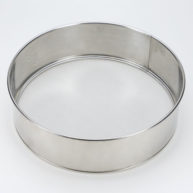I have noticed most of the recipes call for bread flour in addition to any freshly milled whole wheat (red and/or white) to make up the flour component. It seems that using 100% freshly milled whole wheat flour is either much more difficult or I have been approaching this in the wrong way or both.
There are number of recipes on the site that use only whole grain flour (I’ll put links to some below), but you’re correct in observing that the majority are a mix of bread flour and whole grain flour.
In the recipes I’ve developed, I often do this to combine the manageability and airiness of a strong gluten dough with the amazing flavors and nutrients of a whole grain dough. This isn’t to say that bread flour is always “easy” or whole grain bread can’t be airy – just talking averages.
One thing I think I should explore more of, simply because I rarely do it, is using bolted flour or home-sifted fresh milled whole grain flour for all the flour in a dough. Adding that to my to-do list… : )
For the einkorn and amaranth recipe that was published yesterday, to make it 100% whole grain, I would suggest substituting a strongish hard red wheat for the bread flour and leaving the einkorn and amaranth at 16% each. I’d also up the hydration to at least 80% or 320g because of how much thirstier the whole grain wheat will be than the bread flour.
Let me know if there’s any other recipe you’re curious about converting to whole grain – I’d be happy to help.
Thank you Melissa.
With moving to milling my own flour I was of the understanding that artisan bread was also made from all whole grain thus 100% fresh milled flour. That is in addition to natural leavening the dough. Being unbonded, I read somewhere the bran can actually “cut” the gluten strands which keeps the dough from rising fully. This may have been my problem with the bulk rise which was not happening. It sounds like I should use bonded flour if I am using 100% fresh milled whole grain.
Bob
Or using organic I bleached bread flour as purchased ( ie King Arthur or Bob’s Red Mill).
Artisan can mean many different things depending on whom you ask, but usually I take it to mean small scale production, carefully sourced ingredients, created by a person with a passion for the craft. I think Breadtopia’s bread flour meets the criteria of a carefully sourced ingredient. And I also think making 100% whole grain bread is a great craft.
My advice would be to make the bread you enjoy creating and eating. Home-milling all of the flour for your bread is very satisfying as a concept and as an end product.
Some whole wheat flours perform more or less similarly to bread flour from the standpoint of gluten development. Yes, bran interferes with gluten development but not catastrophically.
Here’s another blog post you might be interested in:
I bake primarily 100% whole grain, home milled bread. I’ve had good luck with sifting the flour and then re-milling what remains in the sieve 2 or 3 times. It only takes a couple extra minutes. I also then give the re-milled bran as long a soak as I have time for. When it’s cool in my kitchen, I try to do a final overnight starter feeding that I leave on the kitchen counter and at the same time as I do the last feeding, I mix the bran with all the water in the recipe and let it soak overnight. I find that doing these softens the bran considerably, resulting in a better texture, more spring and bloom, and a more bread-like rather than cakey texture.
Thanks to both of you. I own a sifter like the one grandma had. Will this do? I really appreciate how willing folks are to help.
Bob
Chances are that grandma’s sifter will not be a fine enough mesh, but you can certainly try it. Or you could also try a fine mesh sieve if you have one. If it’s not fine enough, you’ll know because all the flour you’ve milled will go right through it.
I use a sifter like the one available on the Breadtopia site that looks like this:

For me, it’s an essential tool and worth the investment.
Good luck!
On the subject of “Bread Flour”. What it really is? Is this just hard grain flour sifted? with what sieve mesh?
Thanks
Thanks to all. I placed an order for the 40 mesh. I am really enjoying getting back to bread baking, also the higher moisture dough.
My loaf of rosemary lemon bread. Thanks to all for the continued help. 
That’s beautiful! I remember falling in love with the rosemary lemon bread when I baked it!
Leah
I too have used this sifter for several years now with all my sourdough breads and home ground grains, cuz I read it’s the bran that cuts into the dough’s air pockets (I give the bran to my chickens). But I’ve not soaked the bran. That reminds me of the Tartine 3 book sourdough bread technique. I’m a believer in the longer bread making process of soaking overnight. And I’ve mentioned before, I refrigerate the dough for that final long soak (sometimes even for days) and feel baking from the cold dough, that I form on counter from the fridge and not let set out long to rise, but go straight into preheated oven. When I remove the pan lids half-way thru the bake time, they have really risen nicely.